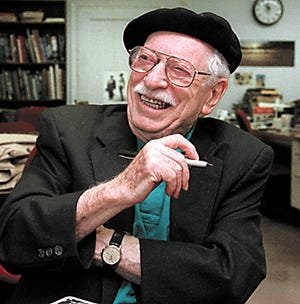A Special 4th of July Blog: Joe Rosenthal’s Iconic Flag Raising at Iwo Jima (1945)
As we celebrate Independence Day, reflecting on the sacrifices and courage that have shaped our nation is essential. One of the most powerful and enduring symbols of American resilience and patriotism is Joe Rosenthal’s iconic photograph, Flag Raising at Iwo Jima. Captured on February 23, 1945, during one of the most intense battles of World War II, this image has transcended time, symbolizing unity, heroism, and the unyielding American spirit. In this special 4th of July blog, we take a deep dive into the photographer, his extraordinary moment behind the camera, the camera he used, where the image was published, and the impact it left on history.
Who Was Joe Rosenthal?
Joe Rosenthal
Rosenthal was a photographer in the Associated Press' San Francisco bureau when the U.S. entered the war, and after his initial efforts to join the fight went for naught, he settled for a photography assignment with the U.S. Maritime Service. That duty saw him travel to the Mediterranean and England, but he was never in the midst of the action.
Joe Rosenthal was born on October 9, 1911, in Washington, D.C. The son of Russian Jewish immigrants, he developed a love for photography early on. He pursued a career in photojournalism, working for newspapers in San Francisco before joining the Associated Press (AP) during World War II. His work as a war photographer led him to document some of the most harrowing and historic moments of the Pacific Theater, including the battle for Iwo Jima.
Despite being rejected for military service due to poor eyesight, Rosenthal was determined to contribute to the war effort through his lens. His dedication to capturing the raw reality of combat ultimately led him to take one of the most famous photographs in history.
Capturing the Iconic Image
The Battle of Iwo Jima was a pivotal confrontation between American forces and the Japanese Imperial Army. The island was a strategic stronghold, and its capture was crucial for U.S. forces in the Pacific. On February 23, 1945, after days of intense fighting, six U.S. Marines raised an American flag atop Mount Suribachi. This moment was significant, but it was actually a second flag-raising that became immortalized.
Joe Rosenthal was with a group of combat photographers when he learned that a second, larger flag was being raised to replace the initial one. Rushing up the mountain, he positioned himself at the right angle and instinctively snapped the photo with his Speed Graphic camera, using a 4x5-inch film negative. He later recounted that he had no time to frame the shot—it was a spontaneous moment, one that would define his career and become a symbol of American perseverance.
The Camera Used
Rosenthal used a Speed Graphic camera, one of the most widely used press cameras of the time. It was a large-format camera that required skill to operate, and photographers had to manually adjust focus and exposure before taking a shot. The image was captured on black-and-white film and remains one of the most well-composed and striking wartime photographs ever taken.
Publication and Immediate Impact
The photograph was quickly sent to the AP and published in newspapers across the United States. It appeared on the front pages of major publications, stirring a wave of patriotism and hope among the American public. The image was so powerful that it earned Joe Rosenthal the Pulitzer Prize for Photography in 1945, making it one of the few images to receive such an honor within the same year it was taken.
Beyond newspapers, the image became the model for the Marine Corps War Memorial in Arlington, Virginia, a massive statue that stands as a tribute to the men who fought and sacrificed for their country.
What Flag Raising at Iwo Jima Represents
This photograph is more than just an image—it is an embodiment of American bravery and perseverance. The soldiers in the picture represented the unity and effort required to achieve victory in one of the war’s bloodiest battles. Over the years, the image has been used in various ways, from war bonds advertisements to history textbooks, ensuring that future generations recognize and appreciate the sacrifices made by those who served.
Joe Rosenthal’s Later Years and Death
Despite achieving international fame, Rosenthal remained humble and dedicated to his craft. After the war, he continued working as a photographer, capturing civilian life and newsworthy events. He later worked for the San Francisco Chronicle until his retirement.
Joe Rosenthal passed away on August 20, 2006, at the age of 94. His legacy, however, lives on through his powerful imagery. He never saw himself as a hero but rather as someone who had the privilege of witnessing and documenting history.
Final Thoughts: A 4th of July Reflection
As we celebrate the 4th of July, let us remember that the freedoms we enjoy today were secured through sacrifice, courage, and determination. Joe Rosenthal’s Flag Raising at Iwo Jima serves as a timeless reminder of these values. It is a moment frozen in time that continues to inspire generations of Americans.
Happy Independence Day, and may we always honor those who fought for the liberties we cherish today.




